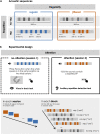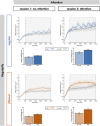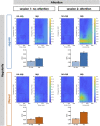Neural signatures of automatic repetition detection in temporally regular and jittered acoustic sequences
- PMID: 37948467
- PMCID: PMC10637696
- DOI: 10.1371/journal.pone.0284836
Neural signatures of automatic repetition detection in temporally regular and jittered acoustic sequences
Abstract
Detection of repeating patterns within continuous sound streams is crucial for efficient auditory perception. Previous studies demonstrated a remarkable sensitivity of the human auditory system to periodic repetitions in unfamiliar, meaningless sounds. Automatic repetition detection was reflected in different EEG markers, including sustained activity, neural synchronisation, and event-related responses to pattern occurrences. The current study investigated how listeners' attention and the temporal regularity of a sound modulate repetition perception, and how this influence is reflected in different EEG markers that were previously suggested to subserve dissociable functions. We reanalysed data of a previous study in which listeners were presented with sequences of unfamiliar artificial sounds that either contained repetitions of a certain sound segment or not. Repeating patterns occurred either regularly or with a temporal jitter within the sequences, and participants' attention was directed either towards the pattern repetitions or away from the auditory stimulation. Across both regular and jittered sequences during both attention and in-attention, pattern repetitions led to increased sustained activity throughout the sequence, evoked a characteristic positivity-negativity complex in the event-related potential, and enhanced inter-trial phase coherence of low-frequency oscillatory activity time-locked to repeating pattern onsets. While regularity only had a minor (if any) influence, attention significantly strengthened pattern repetition perception, which was consistently reflected in all three EEG markers. These findings suggest that the detection of pattern repetitions within continuous sounds relies on a flexible mechanism that is robust against in-attention and temporal irregularity, both of which typically occur in naturalistic listening situations. Yet, attention to the auditory input can enhance processing of repeating patterns and improve repetition detection.
Copyright: © 2023 Ringer et al. This is an open access article distributed under the terms of the Creative Commons Attribution License, which permits unrestricted use, distribution, and reproduction in any medium, provided the original author and source are credited.
Conflict of interest statement
The authors have declared that no competing interests exist.
Figures




References
-
- Chait M. How the brain discovers structure in sound sequences. Acoust Sci Technol. 2020;41(1): 48–53.
MeSH terms
LinkOut - more resources
Full Text Sources

